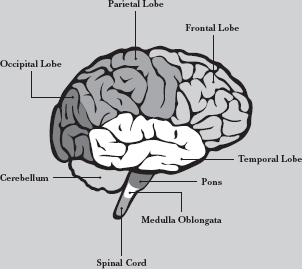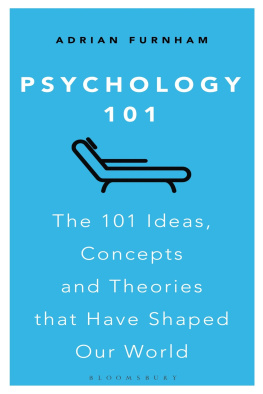


IMAGE CREDITS
pp.1, 58, 1013, 1618, 2025, 2743, 4547, 4971, 7377, 8081, 8384, 86102, 105108, 110113, 115128 IhorZigor/Shutterstock.com; p.4 Zubdasfy Shutterstock.com; p.9 Pranch/Shutterstock.com; p.15 Athanasia Nomikou/Shutterstock.com; p.18 Designua/Shutterstock.com; p.19 maglyvi/Shutterstock.com; p.26 Arcady/Shutterstock.com; p.31 T and Z/Shutterstock.com; p.48 desdemona72/Shutterstock.com; p.72 Peter Hermes Furian/Shutterstock.com; p.78 bygermina/Shutterstock.com; p.79 Alex Gorka/Shutterstock.com; p.82 Dmitry Guzhanin/Shutterstock.com; p.85 bsd/Shutterstock.com; p.104 Plateresca/Shutterstock.com
The History of Psychology
Its difficult to know where to begin when describing the history of psychology. In part this is due to the difficulty in separating the study of psychology from that of philosophy. In ancient Greece, philosophers discussed subjects that we would commonly associate with psychology today, such as the soul, the mind, and the nature of thought. However, it wasnt until around the 1800s that psychology emerged as a discipline in its own right, when German scientist Wilhelm Wundt (18321920) began using the scientific method to study human behavior.
Wundts 1874 book, Principles of Physiological Psychology, was a first major attempt to link the studies of physiology (how our organs and organ systems function) and human behavior. He opened the first official Institute for Experimental Psychology in Leipzig, Germany in 1879 and pioneered the use of introspection as a research method.
Try introspection
Light a candle and watch it flicker, play a single note on an instrument or smell a flower. Now say out loud how this makes you feel, or what thoughts you have. This is introspection: examining your own mental processes.

Wundts method of introspection was innovative because he was attempting to study the thought processes themselves, rather than observable behavior or the structure of the brain in isolation. Participants were guided to examine and report their own internal thoughts and to self-observe. Trained staff would monitor the experience, presenting planned sensory stimuli in a controlled way, such as sounding a metronome or turning on a light. Wundt recognized the importance of using experimental methods to study human behavior, and emphasized the need to be able to repeat an experiment within the same conditions, so that the reliability of results could be tested.
Since then, the scientific study of human behavior has flourished, with psychologists employing the scientific method with varying degrees of rigour to explain how the interaction between our biology and our experiences can shape our behavior.
In this book we will discuss the major fields of study in psychology today, from Freuds psychodynamic approach, which emerged in the early twentieth century, to modern brain imaging techniques.
The Biological Approach
Where our thoughts and behaviors originate from has been a source of much reflection by philosophers and scientists during human history, and is still not a question with an absolute answer. However, as our understanding of biology improves, so does our understanding of psychology. In this chapter, we will explore the anatomy of the brain, the influence of genetics and how our evolutionary past may have influenced human behavior.
It was around 2,500 years ago that Hippocrates first argued that it was the brain that was responsible for human thought and consciousness, and not the heart, as Aristotle believed. During the centuries that followed, many theories were put forward about how the brain may contribute to the human experience, including the Greek philosopher and surgeon Galens ideas (developed in the second century CE, but still popular even as late as the seventeenth century) that the brain acted almost like a pump, pushing fluid through nerves to our organs. If it wasnt for scientists morbid experiments attempting to re-animate executed prisoners in the nineteenth century, we may never have considered that our bodies were actually controlled by electrical signals traveling to and from our brains. At a time when electricity was not yet widely used, this was an important development in our knowledge of biology.
However, it didnt matter how inspired scientists were by the idea of an electrically charged biological supercomputer controlling our bodies; they unfortunately lacked the medical knowledge to keep a willing patient alive long enough to open up their skull and actually observe anything. In a time before brain imaging technology, such as Magnetic Resonance Imaging (MRI) and Positron Emission Tomography (PET) scanners, our information came from the misfortunes of people who had endured horrendous injuries and survived, allowing scientists to observe the changes to their personality, behavior or memory as a result.
The most famous of these case studies took place in 1848 when Phineas Gage, an American railway construction foreman, suffered a brain injury when a 43-inch-long iron pole was propelled through his skull during a workplace accident. Gage was using the pole to tamp explosives into a hole during the construction of a railroad bed in Vermont. The pole pierced Gages frontal lobe but miraculously did not kill him. It did, however, leave him with impaired cognitive functions and personality changes. Gages doctor (Dr John Harlow) and friends reported that he had become more impulsive and less able to control his anger after the accident.
The evidence surrounding Gages case is limited and in recent years researchers have questioned the accuracy of some sources, but whether or not his case has been embellished or distorted, it remains the first-known reported case in which brain damage caused alterations in personality. Doctors at the time were able to hypothesize that these personality changes were a direct result of Gages injury, meaning that this unfortunate incident pointed the way and helped us to start mapping the brain. From further case studies and by using new brain imaging techniques, we now know that the frontal lobe (which had been damaged in Gages case) is indeed linked to controlling our impulses, which can vary from resisting the urge to devour another biscuit to the compulsive behaviors that are seen in disorders such as Obsessive Compulsive Disorder (OCD) and addiction.
The lobes of the brain
Each lobe of the brain is associated with a different function.

There are four lobes that make up the human brain: the frontal, temporal, parietal, and occipital lobes. Each of these lobes is associated with specific functions. The frontal lobe is responsible for our executive functions, the higher-level processes that allow us to make decisions, think creatively and initiate or inhibit actions. In the temporal lobe, memories and language are processed for understanding, while the parietal lobe helps us perceive, interpret, and make sense of the world. Finally, the
Next page
















